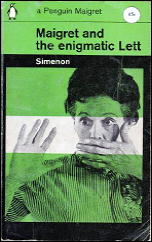Thu 19 Jul 2012
A 1001 MIDNIGHTS Review: GEORGES SIMENON – The Strange Case of Peter the Lett.
Posted by Steve under 1001 Midnights , Reviews[4] Comments
by Francis M. Nevins
GEORGES SIMENON – The Strange Case of Peter the Lett. Covici Friede, US, hardcover, 1931. Hurst, UK, hardcover, 1933. Also published as Maigret and the Enigmatic Lett. Penguin, US/UK, paperback, 1963. Translation of Pietr-le-Letton (Paris, 1931).

Commissaire Jules Maigret is to French crime fiction what Sherlock Holmes is to British: the detective, the immortal. He has appeared in more than seventy novels and countless short stories and novelettes, translated into dozens of languages and turning their author, Belgian-born Georges Simenon, into not only the most famous of European novelists but the wealthiest.
In a very real sense, however, the Maigrets aren’t mystery fiction at all. They contain no clues and deductions and usually only the barest minimum of plot. The great-hearted bear of an inspector does not reason from data; instead, he enters a milieu, walks around in the rain, patiently sucks on his pipe, stops in the local brasserie for a beer or calvados, mingles with the people and absorbs atmosphere until he is so much at one with his environment that the truth is clear to him.
Simenon’s great strengths as a writer lie in the domains of character and setting. Already wealthy from the hundreds of books he wrote in the Twenties, Simenon created Maigret in 1929 while his bark Ostrogoth on which he was touring the canals of Europe was laid up for repairs at the Dutch port of Delfzijl.

The town has since erected a statue of Maigret to commemorate the occasion. He wrote a Maigret a month for the next year and a half. Those first eighteen Maigrets are ranked by many I connoisseurs as the finest Simenon ever wrote, although the first two are in some ways untypical.
In The Strange Case of Peter the Lett, the first Maigret to be written, Simenon borrows from contemporary British thrillers to such an extent that his first London publishers promoted him as the Edgar Wallace of France.
Maigret’s adversary in this debut novel is a chameleon-like mastermind with several identities and a wild scheme to organize the international gangster community. But Simenon uses this plot as he uses the domestic intrigues in his more typical Maigtets — as a screen on which to project the shadow play of character and atmosphere.
And even in his first Maigret, he draws people and milieu with breathtaking skill — from a tormented Latvian intellectual to a passionate female derelict, and from a snobbish Paris luxury hotel to a squalid fishing village.
More in the Maigret mainstream is M. Gallet Decede (1931). (Its first English translation was as The Death of Monsieur Gallet, Covici Friede, 1932, and Penguin has kept it in print for more than twenty years as Maigret Stonewalled.)

Here as usual the inspector probes a crime of private nature, the strange death and even stranger life of a petit bourgeois jewelry salesman who seems — like many of Simenon’s most compelling characters — to have had at least two identities.
Unlike most Maigrets, this one is modeled on the British deductive puzzles of the Golden Age, with a beautifully dovetailed plot, genuine clues, and a noble surprise ending.
Though filtered through translations that are sometimes terrible, Simenon’ s evocations of sight and sound and smell and feel bring places to life with such immediacy that readers who have never been to Europe are ready to swear they’ve seen the milieus he describes.
The same skills vivify the shorter Maigrets that Simenon wrote for French magazines in the middle and late 1930s. Two generous selections of these stories and novelettes are available in the collections Maigret’s Christmas (1977) and Maigret’s Pipe (1968).
———
Reprinted with permission from 1001 Midnights, edited by Bill Pronzini & Marcia Muller and published by The Battered Silicon Dispatch Box, 2007. Copyright © 1986, 2007 by the Pronzini-Muller Family Trust.
NOTE: This and the following three books reviewed are part of this week’s tribute to author Georges Simenon on Patti Abbott’s blog and her ongoing Friday’s Forgotten Books series:
Maigret’s Boyhood Friend.
The Blue Room and The Accomplices.
The Venice Train.
For the reviews posted by others today, follow the link to Patti’s blog.
[UPDATE] 07-23-12. Add to the list of relevant posts above:
A TV Review by Mike Tooney: MAIGRET “Maigret et l’affaire Saint-Fiacre” (1995).
July 20th, 2012 at 1:20 pm
These reviews really bring back a ton of memories. 1001 MIDNIGHTS was a wonderful project. So many great writers were involved. And Nevins’ reviews of Simenon show the quality of writing in this classic reference book.
July 20th, 2012 at 1:59 pm
Of these two early Maigret’s, I am surprised to see that Mike refers to the first one as a thriller, and the second as a Golden Age detective puzzle.
I haven’t read either one — most of my reading of Simenon has been of his short story collections, such as MAIGRET’S CHRISTMAS, which I enjoyed completely — but this review of Mike’s has piqued my curiosity.
July 20th, 2012 at 2:03 pm
The early Maigrets from 1931 paint a fascinating picture of Entre Deux Guerres France.
As Nevins points out, the plot is not the strong point in these books- it is places and people, and both in their time.
The Doc
July 20th, 2012 at 7:30 pm
I read a ton of Maigrets and a lot of biographies of Simenon back in the last century to write the entries on both author and character for the Oxford Companion to Crime and Mystery Writing. I remember what a joy the Maigrets were and what a strange person Simenon seemed to be.